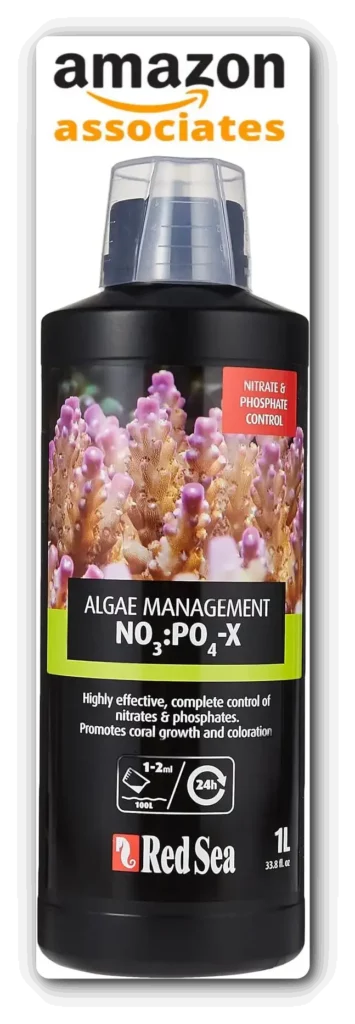If unsightly algal growth has marred the splendor of your aquatic display, fear not! In this comprehensive guide, we unveil the top 13 algae-eating marvels that can restore balance to your aquarium ecosystem. From snails and fish to sea slugs and bacteria, each creature plays a vital role in combating various types of algae.

So lately you’ve been somewhat disappointed with the unwanted algal growth in your marine tank. Luckily there are some great saltwater algae eaters that could control this growth and get your display aquarium back on track.
Various types of algae-eating marine snails and blennies would clean the algae in nano tanks, and some bulkier fish and slugs could eat the stuff in larger tanks.
A well-thought Clean Up Crew could put an end to most hair algae outbreaks, and keep under control microorganisms such as brown Diatoms or red slime algae.
Bubble algae is another story, but I’ll give helpful pointers for that as well.
Anyway, in this article, you’ll learn about some fantastic algae eaters that could rid your saltwater aquarium of the nuisance once and for all.
The Top 13 Saltwater Algae Eaters for a Clean Aquarium
Before I go on to list some algae-eating creatures, I should first point out that there are many types of algae that could sprout in a saltwater tank.
No one creature I’m about to list will be able to eat everything, but a combined Clean-up Crew could control the following algae types:
- Hair algae;
- Film algae;
- Filamentous algae – looks like soft mesh-like growth that is essentially the extension of overgrown film algae;
- Red slime algae, also known as cyanobacteria;
- Diatoms or brown algae;
- Bubble algae;
- Bryopsis algae;
- Dinoflagellates.
There could be many causes behind the bloom of each type of algae and ultimately, you’d want to tackle the core issue.
However, algae eaters will help you with the initial eradication of the nuisance and give you a kick-start for the removal process.
Or you could keep the cleaners and let the algae supplement their diet.
Anyway, take a look at the best saltwater algae eaters to control an outbreak in an aquarium:
1. Tuxedo Urchin – Mespilia globulus

| What it Eats: | all short hair and film algae types, green hair algae, sometimes coralline, detritus |
| Key Traits: | carries objects from around the tank as a camouflage; can be like a small bulldozer; amusing to watch and non-reef keepers will likely comment on it; needs to eat algae constantly, so you should supplement it with Nori after yours is gone |
| Maximum Size: | about 3 inches (7.6 cm) |
| Recommended Tank Size: | 20 gallons, as long as you supplement your nano tank with enough food for your Tuxedo Urchin |
This type of sea urchin is a member of the Mespilia genus.
The Tuxedo Urchin is known to demolish most short and long hair algae in saltwater tanks of all sizes, with the green hair one being its favorite.
These creatures have sharp teeth that scrape the green hair algae off your rocks and other surfaces and will sometimes leave a lawnmower-like trail.
Tuxedo Urchins sometimes eat coralline algae too, but most users that revert to their services consider that a worthy trade-off for having a clean tank.
The thing about Tuxedo Urchins is that they can be really naughty sometimes.
For example, the Urchin will bulldoze through aquarium decor that’s not well-glued to the ground.
Another funny trait of the Tuxedo Urchin is that it will “carry” small objects on its back for camouflage.
The objects will not be spiked but rather picked up with the Urchin’s feet. These camouflage objects may include small coral fragments, zoanthids, and even live crabs!
It looks somewhat unbelievable, but here is a photo of a Tuxedo Urchin doing its thing:

2. Mexican Turbo Snail – Turbo fluctuosa
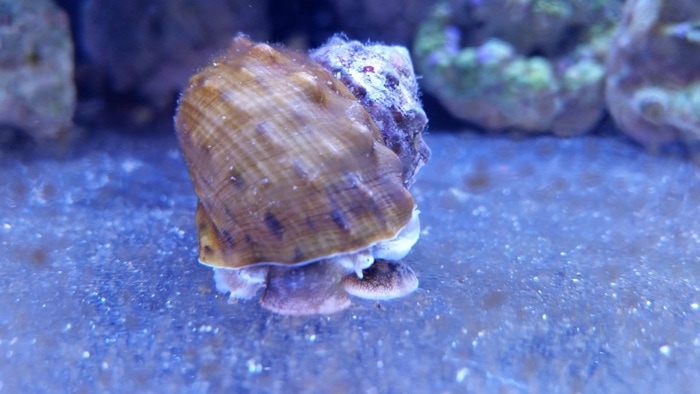
| What it Eats: | all sizes of hair algae, slime algae, film, brown algae |
| Key Traits: | Needs a constant source of algae; will bulldoze through decor on occasion; completely reef safe |
| Maximum Size: | 2 inches but old, well-fed specimens may reach up to 2.5 (5 cm to 6.3 cm) |
| Recommended Tank Size: | 20 gallons |
Coming from the Turbo genus, the Mexican Turbo Snail is a bulky saltwater snail that is an algae-cleaning powerhouse.
These snails will tirelessly roam your reef tank for all types of algae to munch on.
What makes the Mexican Turbo Snail a fantastic algae eater is its ability to devour robust types of hair algae that almost no other snail would touch.
This includes the stringy green hair algae that many of us have had in our tanks.
The only disadvantage to having Mexican Turbo Snails in your reef tank is their ability to bulldoze through the decor. Your rockwork needs to be well-positioned and your corals – anchored with some sort of reef safe super glue.
Another thing to consider before getting a Turbo snail is the water temperature in your tank – Turbos will not thrive in tropical temperatures.
Here’s what a single Turbo Snail can do in terms of cleaning the algae from your saltwater tank:

3. Dolabella Sea Hare – Dolabella auricularia
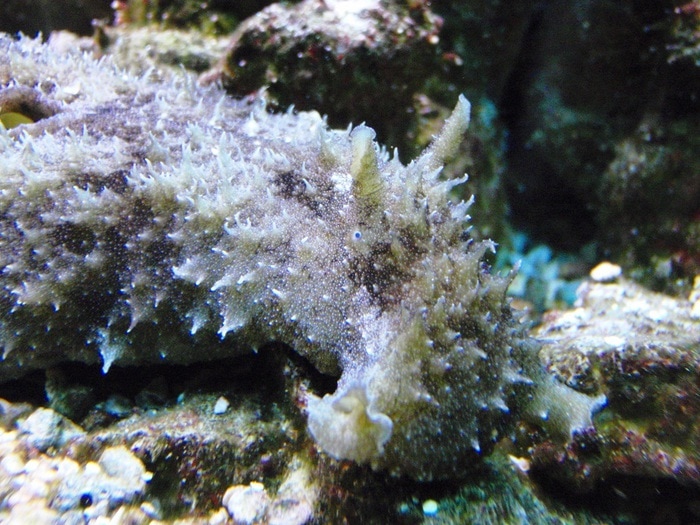
| What it Eats: | pretty much all types of hair algae |
| Key Traits: | is reef safe; powerheads are its enemies due to being squishy and clumsy; eats nothing BUT algae; peaceful |
| Maximum Size: | 16 inches / 40.6 cm |
| Recommended Tank Size: | 75 gallons |
The Dolabella Sea Hares are one of, if not, the best hair algae eaters in the saltwater aquarium hobby. These sea slugs from the Dolabella genus, are phenomenal at eating hair algae at a fast pace. In fact, they’re so good at it, that once the algae are gone your sea hare will starve.
The usual practice with these creatures is putting them in your tank until they demolish all of your algae and then trading them off to the next person with an active outbreak.
Nonetheless, a large mature tank should be able to sustain a Dolabella Sea Hare on its own, and you could feed them algae sheets in smaller tanks.
I chose to list the Dolabella species specifically because they do not tend to release purple ink, and even when they do – the ink is not really toxic and will not nuke your reef aquarium.
Anyway, one thing to be aware of about the Dolabella Sea Hares is that they may not do well in tanks with powerheads in the open. There are many reports of a powerhead pulverizing the sea hare, so powerhead guards should be in place.
4. Tailspot Blenny – Ecsenius stigmatura
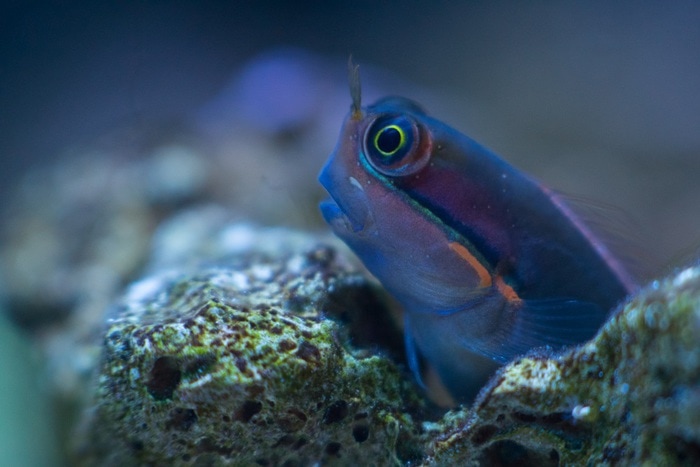
| What it Eats: | film and soft hair algae, sometimes it may eat brown algae |
| Key Traits: | hardy; remains small in size; if hungry it may nip at some corals in search of algae, so keep it well-fed; great personality; peaceful |
| Maximum Size: | 2.5 inches (6.3 cm) |
| Recommended Tank Size: | 10-gallon tank |
The Tailspot Blenny is one small saltwater fish with an enormous appetite. This fish from the Ecsenius genus is a good option for algae control in nano tanks.
It will graze on film and filamentous hair algae (not the string type).
When not in its hiding hole, the Tailspot Blenny would forage your aquarium for food to nip on.
Aside from that, this fish has a great personality and may easily become one of your favorites in the nano tank.
The Tailspot Blenny is not aggressive by any means and does not like the company of aggressive tank mates. Moreover, because of its hardiness and good demeanor, I usually recommend this peaceful fish to beginners with marine tanks.
Author’s note: Some aquarists recommend getting Lawnmower Blennies, but despite their name, these fish can be surprisingly picky eaters and are somewhat of a hit or miss for algae control. The Tailspot Blenny does not grow as large and eats algae more opportunistically than a Lawnmower Blenny.
5. Banded Trochus Snail – Trochus sp.
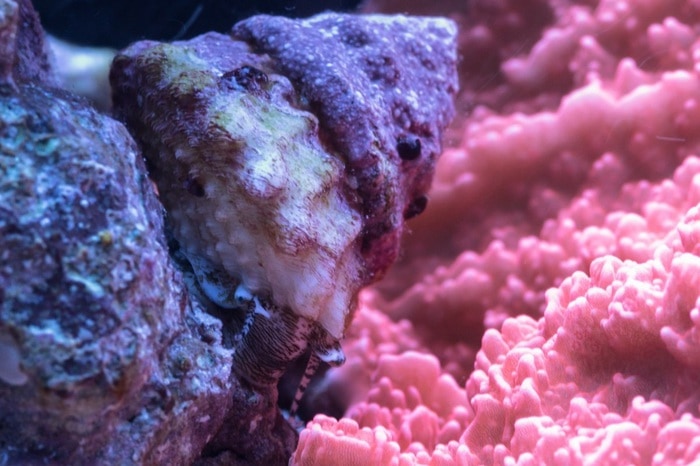
| What it Eats: | green film algae, cyanobacteria, brown algae, detritus |
| Key Traits: | completely safe for reef aquariums; can right itself if flipped over; beautiful; hard worker; hardy |
| Maximum Size: | Generally stay around 1 inch, but reaching 2 is not unseen (2.5 to 5 cm) |
| Recommended Tank Size: | 5 gallons |
The Banded Trochus Snail is a classic member of the Clean Up Crew in many saltwater aquariums.
This mountain-top-shaped sea snail is one of the species within the Trochus genus.
These snails will graze on film and red slime algae, brown diatom algae, and detritus.
They prefer the glass and rocks in the aquarium as their workplace, but may occasionally clean the substrate too.
What I like about these snails is that they can right themselves when turned over.
This is rare when it comes to saltwater aquarium snails and is more than welcome in my nano tanks.
Also, they are hardy and can withstand tropical water temperatures.
Anyway, the Banded Trochus Snail can deal with hermit crabs on its own, which is another huge plus to having it in your saltwater reef tank.
All in all, based on my experience and observations, I rank the Banded Trochus Snail as the second-best saltwater snail for eating algae in aquariums.
The first place obviously goes to the Mexican Turbo Snail.
6. One Spot Foxface Rabbitfish – Siganus unimaculatus
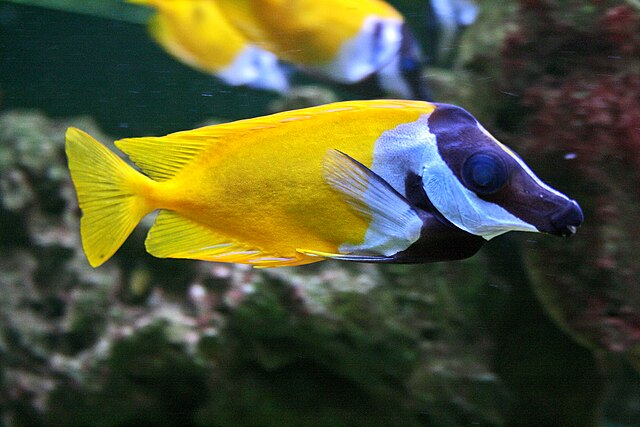
| What it Eats: | String Hair Algae, may or may not consume Bubble algae |
| Key Traits: | May nip on LPS corals and zoanthids if not fed; grows fast; timid; hardy; has a venomous sting (not deadly to humans) |
| Maximum Size: | 8 inches (20.3 cm) |
| Recommended Tank Size: | 70-gallon tank for juveniles and tanks with 70 or more inches of horizontal length for adults |
This type of Rabbitfish is from the Siganus genus of marine fish in the Siganidae family.
The One Spot Foxface Rabbitfish may be your best bet if you’ve set your mind on getting a fish, and not an invertebrate, to deal with your tank’s hair algae problems.
This fish species will pick at most hair algae types, non-nuisance macroalgae included.
I’ve also seen Foxface Rabbitfish eat bubble algae, but it usually takes some time before the fish recognizes it as a food source.
These fish are hardy and are a good addition to any large saltwater aquarium.
I’m saying large because the One Spot Foxface Rabbitfish is a fast grower that reaches about 9 inches in body length.
7. Sailfin Tang – Zebrasoma veliferum
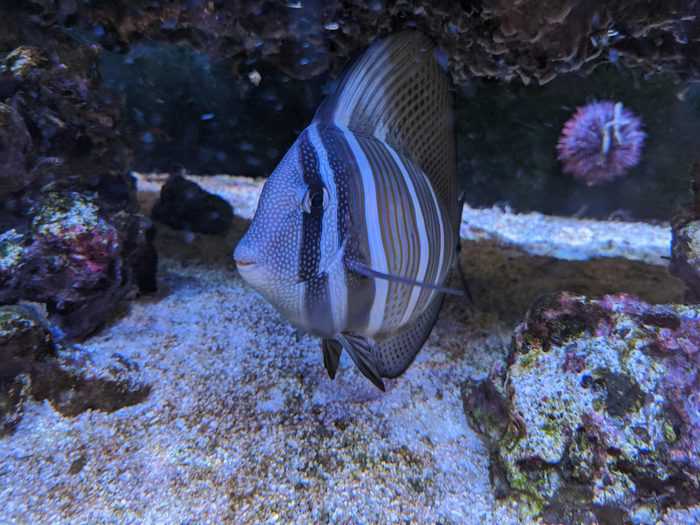
| What it Eats: | Filamentous green hair algae |
| Key Traits: | is known to sometimes pick at LPS corals or zoanthids if not well-fed, but is generally reef-safe; grows large fast; has a peaceful demeanor |
| Maximum Size: | up to 16 inches (around 40 cm) |
| Recommended Tank Size: | 125 gallons |
The Sailfin Tang comes from the Zebrasoma genus and is herbivorous in nature.
Fish from this genus and specifically the Sailfin Tangs make short work of various types of filamentous hair algae.
However, I’ve noticed that there’s an ongoing confusion about these fish and their algae-eating abilities.
For example, some people swear by the Sailfin Tang as their top-performing algae eater, and others say that it just wouldn’t touch the stuff.
The confusion really comes from the type of hair algae these fish prefer.
A Sailfin Tang will eat as much filamentous hair algae as possible, but won’t really be interested in fleshy, string algae.
Filamentous algae are soft, long, and thin, and resembles a spider web or a mesh when dense.
String hair algae are thicker and look more like weed.
8. Bristletooth Kole Tang – Ctenochaetus strigosus

| What it Eats: | Red slime or Cyanobacteria algae, brown diatoms, other film algae, other rock detritus and sometimes even fish waste |
| Key Traits: | is generally reef safe but may develop a habit of picking on certain LPS corals later on; an active swimmer; will get territorial with its own kind |
| Maximum Size: | 7 inches or 17.78 cm |
| Recommended Tank Size: | 60-gallon tank for a single specimen |
The Bristletooth Kole Tang is a member of the Ctenochaetus genus.
The Kole Tang is one of the best and most active herbivorous fish when it comes to eating any form of red slime, or other film algae.
Kole Tangs are excellent for ongoing maintenance because they will also clean your saltwater aquarium’s rocks from any detritus.
Your rockwork would be sparkling once this fish settles and starts mowing the lawns.
The common practice for algae control in saltwater tanks is combining a Bristletooth tang like the Kole Yellow Eye one and a hair algae eater such as the Foxface Rabbitfish.
The Bristletooth Kole Tang would take care of any unwanted film or cyanobacteria and the Foxface would clean the hair algae.
Author’s note: During my research I found some reports of Kole Tangs feeding on hair algae. However, they weren’t convincing enough for me to list the fish as a good cleaner of that type of algae.
9. Quoyi Parrotfish – Scarus quoyi
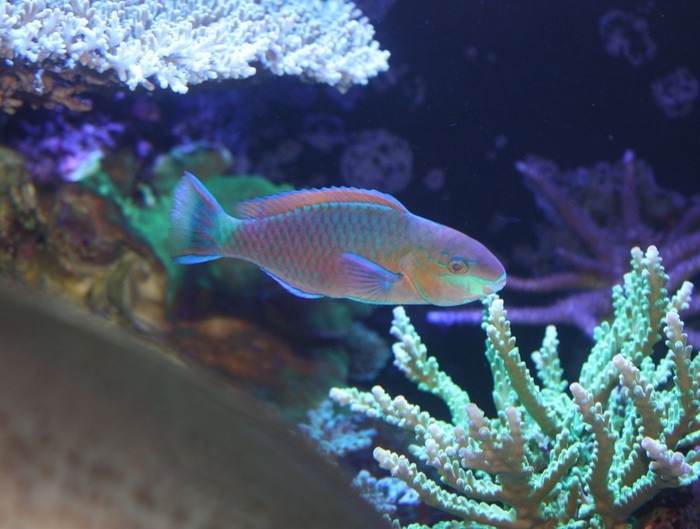
by ca1ore
| What it Eats: | All types of micro and macro algae |
| Key Traits: | Safe for reef tanks; eats constantly and needs a large tank; can be difficult to keep long-term; may have an issue with more aggressive tangs and wrasses; peaceful |
| Maximum Size: | 10 to 11 inches or up to 30 cm in captivity (a slow grower) |
| Recommended Tank Size: | 150+ gallon tanks |
The Quoyi Parrotfish is an herbivorous marine fish from the Scarus genus, and its diet is heavily dependent on algae.
These fish will polish your aquarium rocks and clean every bit of algae that may grow there, non-selectively.
The Quoyi Parrotfish also nibbles on coralline algae, if there’s enough in the tank to spark an interest. This fish species is absolutely safe for a reef aquarium, unlike its close cousins who would feed on corals.
Mind that the Quoyi Parrotfish is difficult to keep long-term and you should only attempt getting one if you’ve done a ton of research beforehand.
10. Female Emerald Crab – Mithraculus sculptus
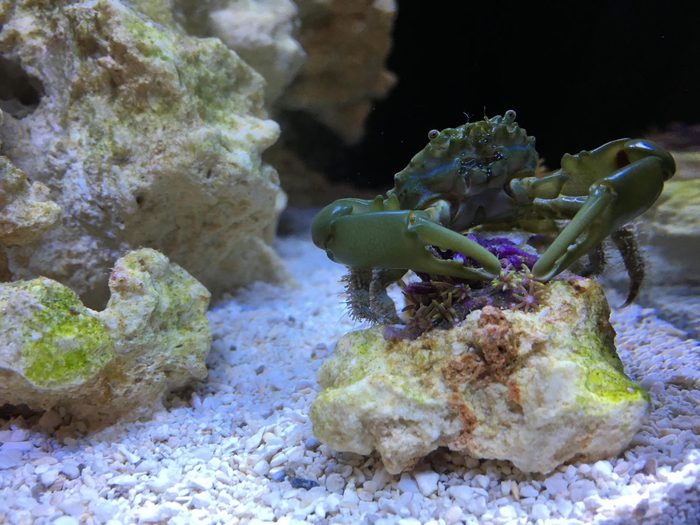
by amazin112
| What it Eats: | Bubble algae, green hair algae, macroalgae in general |
| Key Traits: | females are less aggressive than males; opportunistic omnivore that leans on the herbivorous side; hardy; should be added to reef tanks with caution |
| Maximum Size: | usually around 2 but 2.5 inches is not impossible (5 to 6.35 cm) |
| Recommended Tank Size: | 10 gallons, but a single emerald crab can clean a tank of up to 40 gallons |
The Emerald Crab, which belongs to the Mithraculus genus, is an algae-eating machine, as long as there’s enough of the stuff in the tank. Once algae are gone from your reef aquarium, Emerald Crabs can be found picking on any type of growth, including LPS corals such as the Hammerhead one and SPS corals.
Before you go ahead and write these crabs off, know that they are a prominent algae eater. Emerald Crabs will prioritize eating bubble algae before anything else, and then move on to your tank’s green hair algae reserves.
An Emerald Crab would also eat marine macroalgae plants, so you could just relocate it to your refugium with Chaetomorpha, once your display tank is free of unwanted algae growth.
Related: Top Refugium Lights to Grow Chaetomorpha
11. Court Jester Goby – Koumansetta rainfordi
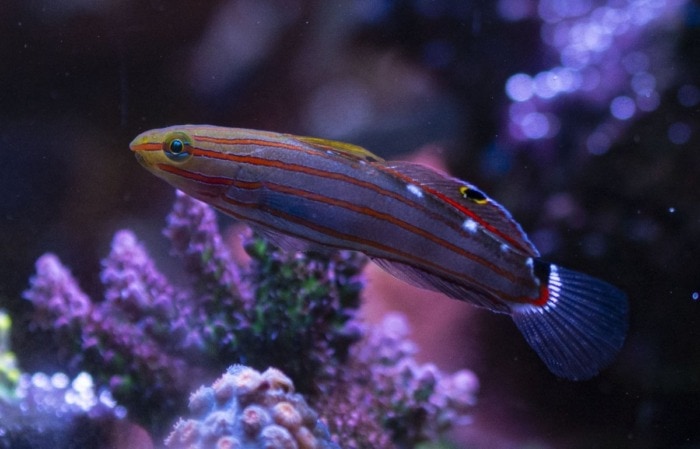
| What it Eats: | Film algae, brown diatoms, but is especially adept at getting rid of red slime algae. |
| Key Traits: | Peaceful; stays small; should be captive-bred for long-term success |
| Maximum Size: | 2.8 inches (7.1 cm) |
| Recommended Tank Size: | mature tank that hold 10 or more gallons |
The Court Jester goby is one of the two known species from the Koumansetta genus.
It grows to a maximum size of just 2.8 inches and needs at least 10 gallons of free space.
But despite its modest size and tank requirements, it has a huge appetite for algae.
And even though court jester gobies mostly graze on film algae and brown diatoms, they won’t miss an opportunity to snack on some red slime algae as well.
In fact, they can take care of a cyanobacteria outbreak in just a week or two, depending on its severity.
Interestingly enough, I’ve found reports that the only other species of the Koumansetta genus (Hector’s goby), also likes to eat red algae.
So if you can’t get your hands on a Court Jester Goby, you can give its cousin a try.
Apart from their sweet tooth for algae, court jester gobies also need a constant supply of live foods in order to thrive.
Due to this, harboring your own cultured foods is highly recommended.
Alternatively, you can feed them with some finely chopped mysis or brine shrimp.
12. Longspine Urchin – Diadema Antillarum

| What it Eats: | Coralline algae, filamentous algae and macro algae in general |
| Key Traits: | Amusing to watch, until it knocks off something it’s not supposed to; reef safe |
| Maximum Size: | 10 inches (25.4 cm) |
| Recommended Tank Size: | 100 gallons |
The Longspine Urchin (Diadema Antillarum) may look like a grotesque creature from a Lovecraft novel, but it’s excellent at algae control nevertheless.
And despite some common misconceptions, it’s completely reef safe as well. In fact, longspine sea urchins are one of the most important herbivores in the Caribbean coral reefs since they reduce algal overgrowth.
As a consequence of this, corals get provided with plenty of reef space to grow undisturbed.
Anyways, longspine urchins are an algae-eating-powerhouse that will scrub your tank clean of most types of macro and micro algae.
Due to their voracious appetite, it’s best to avoid keeping them with crabs or other creatures who they might outcompete for food.
It’s worth pointing out that longspine sea urchins can be quite active, so they need to be kept in a spacious aquarium.
Unfortunately, they’re not the most graceful sea creatures, and will eventually knock off some of your decorations.
13. Cultured Bacteria That Eat Algae
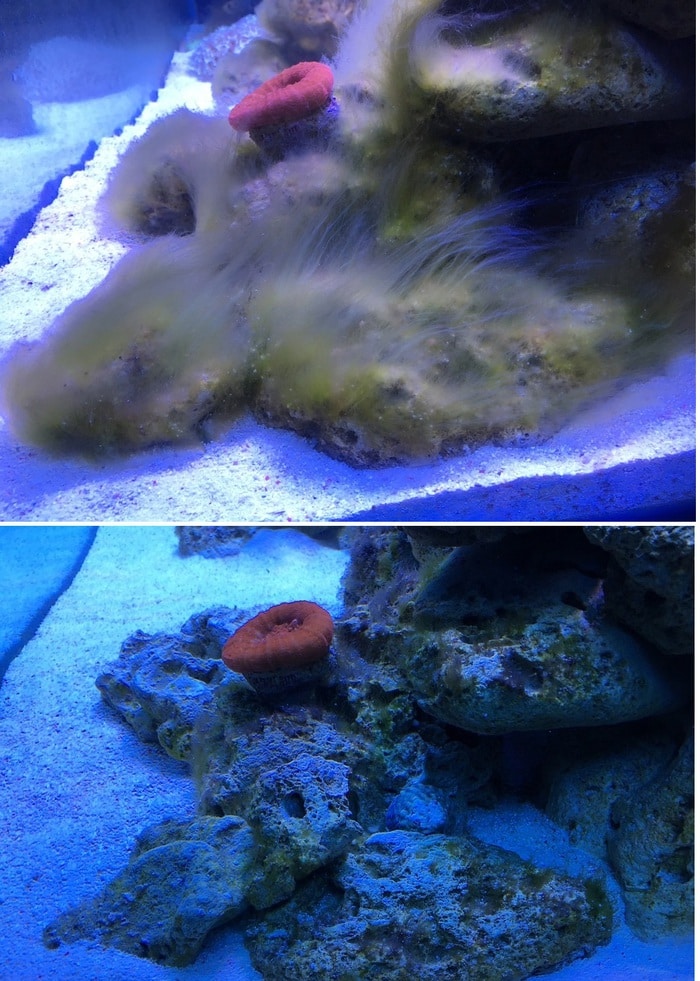
| What it Eats: | All types of nuisance algae; some report their macroalgae losing biomass as well |
| Key Traits: | Generally safe for use in reef tanks; almost maintenance-free; should be used in aquariums with heavy algae infestations |
| Maximum Size: | – |
| Recommended Tank Size: | Any |
There’s a product by Underwater Creations Inc. containing a mix of cultured bacteria that attack marine algae on several fronts.
I haven’t personally used this product but during my research, I was able to find a ton of positive experiences with it and not just reviews on commercial websites.
Reportedly, this bacterial mix could take care of almost all types of algae, including dinoflagellates, Bryopsis, and Bubble algae.
The product itself is called Vibrant and you could check its price over at Amazon by clicking here. You simply add the recommended dose and do nothing while algae disappear.
Anyway, it’s worth noting that these algae-eating bacteria do come with some risks.
The first one is that they will clear any cloudiness from your aquarium water. Though this has its advantages it could lead to some of your corals bleaching if you do not reduce the intensity of your reef tank LED lighting.
Furthermore, your saltwater aquarium should likely have something that would take care of the excess release of Nitrate or Phosphate, because as the algae die, the organisms fill the water with nutrients.
Author’s note: For efficient nutrient export in saltwater aquariums I recommend running a good GFO reactor, a refugium or simply using NO4:PO4-X if you’re okay with using bottled additives.
Anyway, another potential disadvantage would be that the Vibrant Aquarium Cleaner may also wipe out some coralline algae from your tank’s glass.
Moreover, occasionally a user would experience a cyanobacteria bloom after stopping the Vibrant treatment.
Anyhow, before you start wondering why did I even include this product with so many potential disadvantages, let me stop you right there.
The thing is that, for every failure I read about Vibrant, I could find 10+ positive experiences.
All in all, my verdict would be to do your own research and only use this product at your own risk.
My Verdict on the Best Algae-Eating Creatures for Marine Tanks
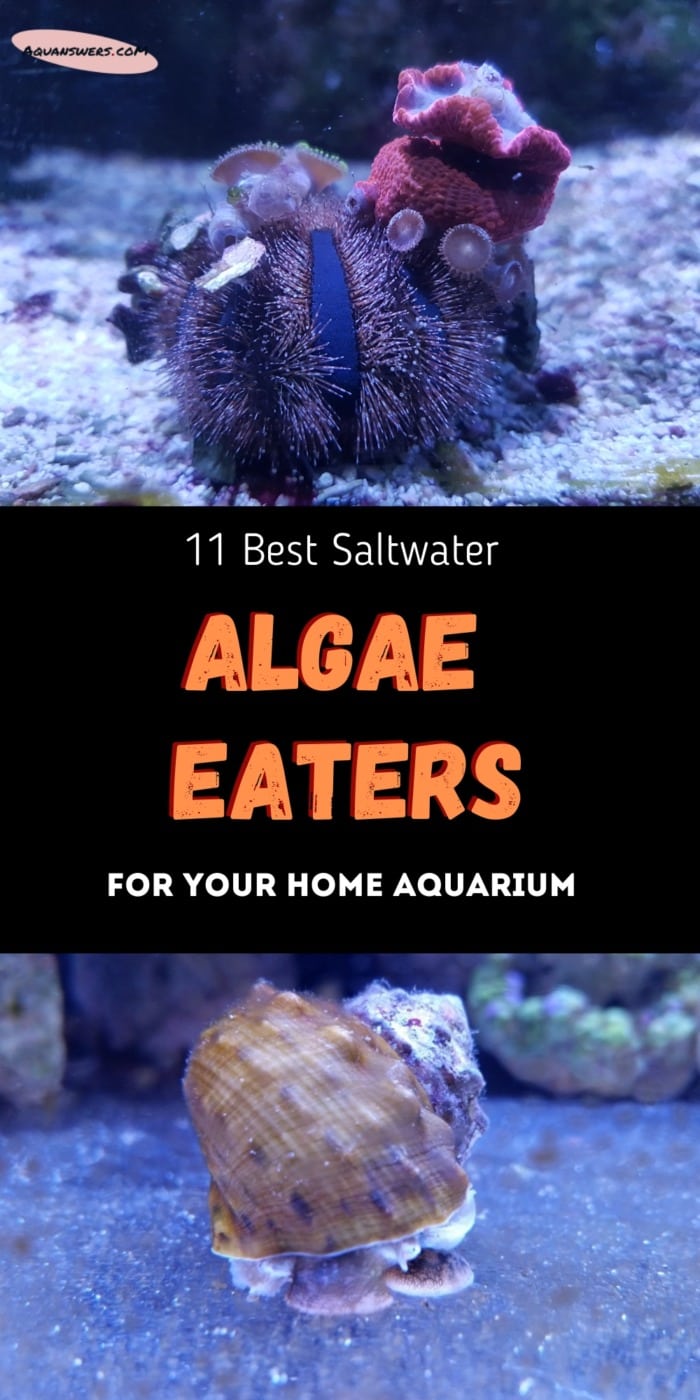
If you have a nano reef tank you could use the following saltwater creatures for algae control:
- Banded Trochus Snail
- Tuxedo Urchin
- Tailspot Blenny
If you have a larger reef aquarium and have a severe algae problem try to introduce a Dolabella Sea Hare to the tank or use the combined efforts of a Foxface Rabbitfish, a Kole Tang, and some Tuxedo Urchins or Turbo Snails.
The saltwater Emerald Crab best fits as an algae eater in larger tanks with plenty of Bubble algae.


